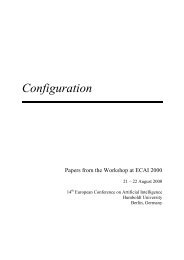An Introduction to BPEL standard and its extentions - SoberIT
An Introduction to BPEL standard and its extentions - SoberIT
An Introduction to BPEL standard and its extentions - SoberIT
Create successful ePaper yourself
Turn your PDF publications into a flip-book with our unique Google optimized e-Paper software.
<strong>BPEL</strong> Process<strong>BPEL</strong> Process<strong>BPEL</strong> Process<strong>BPEL</strong> ProcessPeopleActivityPeopleActivityPeopleActivityPeopleActivityInlineHumantaskInlineHuman taskSt<strong>and</strong>aloneHuman taskCallableWSDLInterfaceHTPro<strong>to</strong>colInterfaceSt<strong>and</strong>alone HumantaskFigure 3.1: Interaction patterns between process <strong>and</strong> task [15]In Pattern 1, the task is specified inline within a People activity. In Pattern 2, the task is specified inlinewithin the <strong>BPEL</strong> process. In both patterns, the task au<strong>to</strong>matically shares process context <strong>and</strong> data.In Pattern 3, the task is defined externally <strong>to</strong> the process without a specific interface, In that wayapplication vendors can expose their functionality as tasks which can be called from <strong>BPEL</strong> processengines.Pattern 4 is like 3 except that the task interface is specified using a callable WSDL, which is invokedusing Web services. Moreover, WS-HumanTask is used for communication between process <strong>and</strong> task.4. WS-<strong>BPEL</strong> 2.0 EXTENSIONS FOR SUB-PROCESSES – <strong>BPEL</strong>-SPE4.1 Dem<strong>and</strong> for <strong>BPEL</strong> -SPEBesides excluding people action, <strong>BPEL</strong> does not support the explicit definition of business “fragments”that can be invoked from another (or the same) business process either [16]. In both the <strong>BPEL</strong>4WS 1.1<strong>and</strong> the WS-<strong>BPEL</strong> 2.0 specifications,, the only way <strong>to</strong> simulate this behavior is <strong>to</strong> define a completebusiness process as an independent service <strong>and</strong> invoke it via invoke activity. However, sub-process iscompletely hidden from <strong>its</strong> parent process, namely it does not have lifecycle coordination with <strong>its</strong> parentprocess.4.2 Development of <strong>BPEL</strong>-SPEIn September 2005, IBM <strong>and</strong> SAP published a white paper called Extensions for Sub-Processes (<strong>BPEL</strong>-SPE). The paper calls for the explicit definition of sub-processes, allowing for the reuse of the subprocess,tight coupling of the sub-process's lifecycle with <strong>its</strong> parent process, <strong>and</strong> the ability of the subprocess<strong>to</strong> access <strong>its</strong> parent processes data [16]. The language specification defining the precise syntax<strong>and</strong> semantics will be published in the future.
















